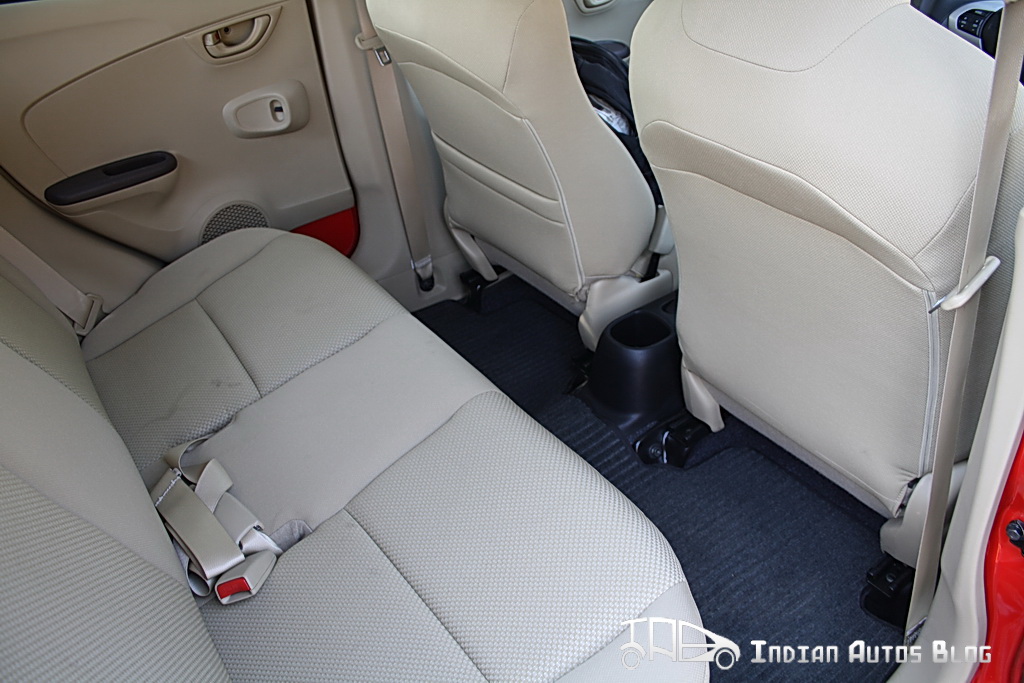Day 2: Honda Brio Interiors Review
 Yes, the Honda Brio does look like a cutesy small car from the outside. Unfortunately, a ‘small car’ may conjure up images of a cramped interior space, legs touching legs and a little bit of elbow action. Further adding to the pain, rival Toyota offers class leading space in its Liva with plenty of storage solutions as well.
Yes, the Honda Brio does look like a cutesy small car from the outside. Unfortunately, a ‘small car’ may conjure up images of a cramped interior space, legs touching legs and a little bit of elbow action. Further adding to the pain, rival Toyota offers class leading space in its Liva with plenty of storage solutions as well.
But there is a chink in the Liva’s armor and that is that the Liva is not a boring car to be in. There is plenty of evidence of cost cutting in Liva’s interior which spoils the party.
So in this horde to shed its premium brand image, has Honda compromised on the build quality?
Let’s find out:
Honda Brio Review - Interiors
Honda claims that their engineers have made the maximum utilization of the 2,345mm wheelbase. There is enough evidence suggesting that their claims do hold some water. If you notice the wheelbase, you will see that the wheels are extended outside to increase more cabin space.
Step inside the Brio and you are in for surprise! The Brio offers plenty of space and at first glance, it doesn’t seem like Honda has compromised on the build quality either. The interior is a pleasant combination of light beige, dark brown and aerosol silver. There are no soft touch plastics like you get in most hatchbacks but somehow the interiors feel like a better place to be in. I think the chief reason for the pleasant interiors is the light beige color which gives it a very roomy feeling. The ingress is very easy thanks to the wide opening doors.
Once inside, the Civic-inspired three spoke steering wheel welcomes you. The steering features mounted controls and is tilt adjustable.
It provides perfect grip for the driver and a blessing-in-disguise is the correct positioning of the indicator and wiper stalk. The steering cannot be adjusted for reach but the Brio’s seats offer such a near-perfect driving position that you don’t have to make many adjustments.
The dials have a red glow which looks quite sporty at night. A small multi information display (MID) between the dials gives you various information such as trip meter, odometer and fuel efficiency. However, to choose the information, you don’t get a button on the indicator stalk. You get a traditional long stick that comes out of the dial console.
Unfortunately, the Honda Brio’s MID does not show km-to-empty which the most important information you need. However a small ‘ECO’ notification lights up when you drive economically. This function is quite useful as we will find out in the driving review.
Unlike performance manufacturers who tilt the center console towards the driver, the Brio’s center console moves away from the driver. Honda claims this is done for safety reason so that the driver is not distracted. Unfortunately, this also makes it less ergonomic to use the AC controls on the center console.
The Brio features an integrated music system which has only USB and AUX ports. The music system does not have a CD player and is a clear indication of the Brio’s target audience. It’s a very smart move because CD ROMs are a bit passé and most youngsters prefer iPods and USB drives for in-car entertainment now. The AUX port is on the head unit whereas the USB port is near the power outlet at the bottom of the center console. Sound quality is pretty descent.
The typical Honda golf-ball gear lever is very small and does not feel chunky to operate. There are some decent storage solutions as well. The door pockets can hold bottles and two cup holders for the front can hold your average coffee cup. The glove box has decent space as well but it is not a chilled one like the one you get in a Toyota Liva.
All is not well in the front. Some exposed metal parts and integrated headrest are clear signs of cost cutting. The pedals are placed perfectly but the dead pedal is absent.
Coming to rear, you can easily see that Honda has tried to liberate as much as leg space as it is possible. The seats have a curved back to increase the volume of space at the rear. 2 fully grown adults can comfortably sit behind. Headroom may be a problem for tall people as the Brio is quite a short car. The 5th person at the back will be very uncomfortable and will make others uncomfortable as well.
To increase the space inside, Honda has compromised the boot space of the Brio which is a paltry 175 liters. However, Honda has added a rear parcel tray to spec list as the glass hatch might invite peepers around.
Things that I did not like the interior:
- The boot space is the biggest Achilles heel for the Brio making it unsuitable for long drives.
- I wish the driver window could have an auto-up function as well.
- Exposed metal parts are a complete NO-NO
- The information display does not show range
- The driver’s seat is not height adjustable making it unsuitable for short drivers.
- The Brio does not have a seat belt height adjust either.
- No climate control
Honda has clearly bestowed the Brio with a massive dollop of ‘smart packaging’. The fit and finish of the interior is top notch with no rattles or squeaks when on the move. The feel of the interior is very pleasant and will keep the incumbents very happy on their journey.
Stay tuned for the driving review as it might surprise you!























